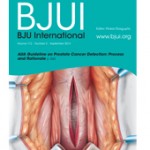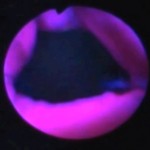Urological oncology in the BJUI
 Urological oncology is increasingly multi-disciplinary, and hence competitive for high impact thought leadership. Innovation leading to paradigm changes may come from a number of different ideas and sources. Effective leadership in our specialty certainly requires technical innovations in surgical treatments, but also pivotal roles in improving the process of diagnosis, staging, patient counselling, multi-modal therapy, and ultimately evidence-based clinical guidelines. The ultimate end-result of innovation is a peer reviewed publication, and at the BJUI we wish to bring you nothing but the highest quality.
Urological oncology is increasingly multi-disciplinary, and hence competitive for high impact thought leadership. Innovation leading to paradigm changes may come from a number of different ideas and sources. Effective leadership in our specialty certainly requires technical innovations in surgical treatments, but also pivotal roles in improving the process of diagnosis, staging, patient counselling, multi-modal therapy, and ultimately evidence-based clinical guidelines. The ultimate end-result of innovation is a peer reviewed publication, and at the BJUI we wish to bring you nothing but the highest quality.
Our daily lives are increasingly busy with our varying mixtures of clinical work, teaching, administration, and research. How much time do we have to read a surgical journal? It is an important part of our learning, but we must be efficient to squeeze it into a busy day. Keeping this in mind, the Editorial Board is more selective than ever in the papers that make it into the BJUI. Each paper we accept needs to represent something valuable to the reader and to our science, such as a technical innovation, large study of a new method to fix an unmet need, multi-institutional validation trial, or updated guideline. For this to work, we need fair and efficient peer reviewers, and high quality submissions.
In this month’s BJUI, we see encouraging work from multiple talented authorship groups who address a plethora of unmet needs. These papers show the diversity of impact the Editorial team is looking for in BJUI urological oncology submissions.
Prostate cancer, of course, is a common topic for new submissions and subsequent citations. In the field of localised prostate cancer and PSA screening, the recent U.S. Preventive Services Task Force (USPSTF) report was critical of our diagnostic practice results in terms of biopsy related complications and, of course, negative (a.k.a. unnecessary, a term we should drop) biopsies. I must confess that I am still stuck in the tradition of the PSA/DRE as the key driver of my recommendation for a biopsy, and several informal ‘raise your hand’ polls at meetings have produced little movement when asked if anyone has adopted newer calculators that incorporate TRUS volume. Why not change? The numbers certainly seem reasonable: an area under the curve (AUC) of 0.71 for DRE/PSA and 0.77 for the risk calculator. You can even make a crude DRE-volume estimate and improve your odds – AUC of 0.73 without and 0.77 with DRE-volume. If that sounds of interest, then perhaps the study by Carlsson et al. in this issue may interest you with their biomarker panel of kallikreins that can do the same work as the combined clinical efforts and reach AUCs of 0.76 alone, or 0.792 if you still want to add the DRE and TRUS volume. I agree with the authors, that this is perhaps a simpler model, which may allow the physician and patient some time to have a look at their risk of a positive biopsy and make a decision, rather than the idea of the last minute TRUS volume that is supposed to put the brakes on a biopsy at a certain size. With further refinement, we can all learn new thresholds for biopsy that are better selected, and in the future should always be calculated as overall cancers detected/missed and high-grade cancers detected/missed.
In addition, the USPSTF criticised the toxicity of a biopsy, and drug-resistant sepsis is an increasing problem. Symons et al. present an instructive series of transperineal biopsies and results, and they seem to have solved the sepsis problem (0.2%), but must weigh the added cost of anaesthesia, physician time, and no obvious difference in bleeding/other minor complications. I am increasingly interested in re-utilising this technique, which previously was only for third-line saturation biopsies. If you are also convinced, Kuru et al. present a tour-de-force presentation of transperineal technique, terminology, and data collection for a multi-centre collaboration.
Finally, in a must-read special article, Carter expands upon the recent AUA guidelines on PSA screening that were intensely debated, especially the recommendations against routine screening in men aged <55 years. Guidelines are an interesting area of study, and can vary in outcome based upon who is on them and what methodology/objectives are selected. If the guideline is meant to be best clinical practice, than the personnel can certainly be influential. However, if the guideline is meant to emphasise evidence-based recommendations, then in theory, any panel of experts will arrive at a similar place. This is the essential message from Carter, that the revised guidelines are meant to reflect the evidence, and currently we do not have level 1 evidence that involved screening men aged <55 years.
Closing this month in ‘Urological Oncology’, Cindolo et al. report an accuracy/generalizability study of the Karakiewicz nomograms for cancer-specific survival with RCC. These articles are, of course, largely statistical exercises, but very necessary, as we define populations suitable for surgery only vs those in need of neoadjuvant/adjuvant inclusion. Wong et al. conclude the month with an innovative report on office-based laser ablation of non-muscle-invasive bladder cancer using local anaesthesia, mostly in an elderly population. The study protocol allowed photodynamic diagnosis, and includes a cost analysis. The results certainly support continued use in this population where we commonly wish to avoid the morbidity of repeat general anaesthetics.
John W. Davis, MD, FACS
Associate Editor, BJUI
Original publication of this editorial can be found at: doi: 10.1111/bju.12380. BJUI 2013; 112: 531–532.



